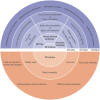Biophysics Role and Biomimetic Culture Systems of ECM Stiffness in Cancer EMT
- PMID: 35712024
- PMCID: PMC9189138
- DOI: 10.1002/gch2.202100094
Biophysics Role and Biomimetic Culture Systems of ECM Stiffness in Cancer EMT
Abstract
Oncological diseases have become the second leading cause of death from noncommunicable diseases worldwide and a major threat to human health. With the continuous progress in cancer research, the mechanical cues from the tumor microenvironment environment (TME) have been found to play an irreplaceable role in the progression of many cancers. As the main extracellular mechanical signal carrier, extracellular matrix (ECM) stiffness may influence cancer progression through biomechanical transduction to modify downstream gene expression, promote epithelial-mesenchymal transition (EMT), and regulate the stemness of cancer cells. EMT is an important mechanism that induces cancer cell metastasis and is closely influenced by ECM stiffness, either independently or in conjunction with other molecules. In this review, the unique role of ECM stiffness in EMT in different kinds of cancers is first summarized. By continually examining the significance of ECM stiffness in cancer progression, a biomimetic culture system based on 3D manufacturing and novel material technologies is developed to mimic ECM stiffness. The authors then look back on the novel development of the ECM stiffness biomimetic culture systems and finally provide new insights into ECM stiffness in cancer progression which can broaden the fields' horizons with a view toward developing new cancer diagnosis methods and therapies.
Keywords: biomimetic culture system; epithelial‐mesenchymal transition; epithelial‐mesenchymal transition stiffness; mechanotransduction; tumor microenvironment.
© 2022 The Authors. Global Challenges published by Wiley‐VCH GmbH.
Conflict of interest statement
The authors declare no conflict of interest.
Figures






References
-
- Roth G. A., Abate D., Abate K. H., Abay S. M., Abbafati C., Abbasi N., Abbastabar H., Abd‐Allah F., Abdela J., Abdelalim A., Abdollahpour I., Abdulkader R. S., Abebe H. T., Abebe M., Abebe Z., Abejie A. N., Abera S. F., Abil O. Z., Abraha H. N., Abrham A. R., Abu‐Raddad L. J., Accrombessi M. M. K., Acharya D., Adamu A. A., Adebayo O. M., Adedoyin R. A., Adekanmbi V., Adetokunboh O. O., Adhena B. M., Adib M. G., et al., Lancet 2018, 392, 1736. - PubMed
-
- Maman S., Witz I. P., Nat. Rev. Cancer 2018, 18, 359. - PubMed
-
- Eble J. A., Niland S., Clin. Exp. Metastasis 2019, 36, 171. - PubMed
Publication types
LinkOut - more resources
Full Text Sources
Research Materials

